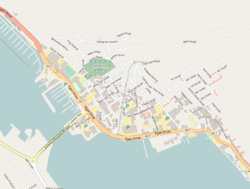
The Alaskan Hotel and Bar, also known as the Northlander Hotel and The Alaskan, is a historic establishment and the oldest operating hotel in Juneau, Alaska. It was opened in 1913. The owners, three miners who struck it rich in the nearby Coast Range, tied the hotel's keys to a helium balloon and released it, signifying that the hotel would never close. The building was briefly condemned in the 1970s, but was rehabilitated by the new owners.

Fort Abercrombie State Historical Park, also known as the Fort Abercrombie State Historic Site, is an Alaska state park on Kodiak Island, Alaska. It includes 182 acres (74 ha) of land at the end of Miller Point, located on the eastern shore of Kodiak Island northeast of the city of Kodiak. The park, established in 1969, is noted for its historical World War II fortifications and its scenery, which includes bluffs overlooking the ocean, spruce forests, and meadows. The site was named in honor of the early Alaska explorer and United States Army officer Lt. Col. William R. Abercrombie. The fortifications, whose surviving elements include gun emplacements, underground magazines, and foundational remnants of buildings, were built in 1941 and abandoned after the war ended, having seen no action.
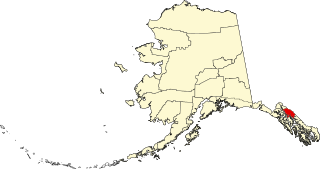
This is a list of the National Register of Historic Places listings in Juneau, Alaska.
Architects of the National Park Service are the architects and landscape architects who were employed by the National Park Service (NPS) starting in 1918 to design buildings, structures, roads, trails and other features in the United States National Parks. Many of their works are listed on the National Register of Historic Places, and a number have also been designated as National Historic Landmarks.

The Alaska Steam Laundry is a historic commercial building at 174 South Franklin Street in Juneau, Alaska. It is a Late Victorian wood-frame structure, with a prominent turret that has a conical roof. Built in 1901, it is a well-preserved element of the transition of Juneau from a mining camp to a more cosmopolitan city. It was built by E. R. Jaeger, who envisioned the laundry as a profitable business serving single miners working the nearby gold mines. The laundry facilities were housed on the ground floor, with residences and office space above. The laundry operated here until 1929, when it was moved to new premises in the city, and this building was converted to other commercial uses.
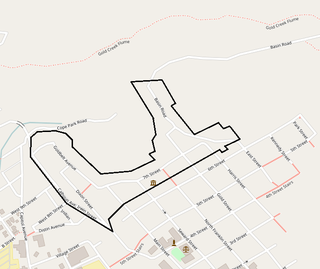
The Chicken Ridge Historic District is a residential historic district in Juneau, Alaska. It is located in an area long known as Chicken Ridge, and has since the early 20th century been one of Juneau's finest neighborhoods. It includes properties along Seventh Street, Basin Road above Seventh, Goldbelt Avenue, Dixon Street, and Main Street above Sixth. Most of the district's 75 contributing and 26 non-contributing properties are Craftsman in style, although the Tudor Revival and Colonial Revival are also well represented.
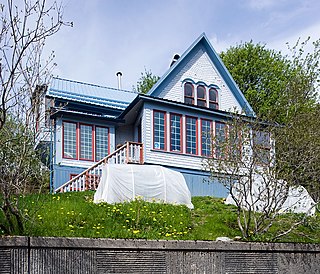
The J. M. Davis House is a historic house at 202 6th Street in Juneau, Alaska. This two-story wood-frame house was built in 1892, when Juneau was little more than a gold mining camp, and remains one of its most elegant homes of the period, as well as one of its oldest buildings. The builder, J. M. Davis, was a miner whose wife was a wealthy English artist. Their son, Trevor Davis, was a noted Alaskan landscape photographer; the house has also served as the official residence of the local US Coast Guard Admiral.

The Frances House is a historic house at 137 6th Street in Juneau, Alaska. The three-story wood-frame house was built in 1898 by Jerry Eicherly, then Juneau's postmaster. In 1911 it was purchased by John Rustgard, the Alaska Territory's attorney general, and in 1927 it was rescued from demolition by Frances Davis, a noted painter of Alaskan scenes, from whom the house derives its name. The house is a notable local example of vernacular Queen Anne styling, with a busy roofline, varied siding, and narrow Italianate windows.
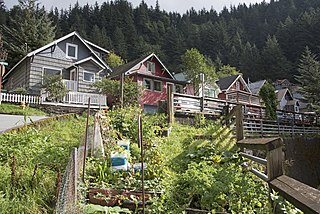
The Fries Miners' Cabins are a group of six small houses located on the 500 block of Kennedy Street, in the Starr Hill neighborhood adjacent to downtown Juneau, Alaska. The six were built as essentially identical structures in 1913 to house miners working in the local gold mines. The houses are 1+1⁄2-story structures of wood-frame construction, and are in the Craftsman style popular at the time. Of the more than 200 miner houses built during Juneau's gold boom, these are among the few that survive.
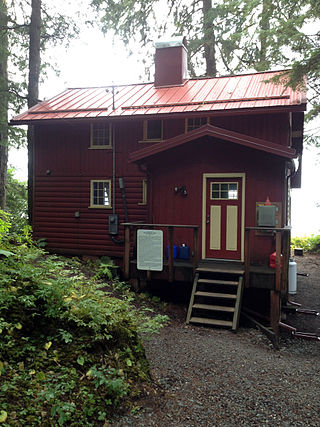
The Ernest Gruening Cabin is a historic rural cabin in Juneau, Alaska, United States, and the centerpiece of Ernest Gruening State Historical Park. It is a 1+1⁄2-story wood-frame structure located 26 miles (42 km) north of the city on the Glacier Highway. It is the only building associated with the life of Ernest Gruening, governor of the Alaska Territory 1939–53, other than the Alaska Governor's Mansion. The cabin was built on land Gruening leased from the United States Forest Service, and was built by local laborers including Gruening's son Hunt. The cabin measures 24 feet (7.3 m) by 28 feet (8.5 m), with a gable roof and a large fieldstone chimney. Its exterior is finished in shiplap siding milled to resemble unfinished logs. The interior consists of a single large chamber, with a circular stairway leading to a sleeping loft above. The kitchen area is set apart from the rest of the space by different flooring, an alteration by Gruening's grandson. The property is now a state historic site.

The Jualpa Mining Camp, also known as the Last Chance Basin Camp, is a former gold mining camp, just outside the city of Juneau, Alaska. Its main building is now operated as the Last Chance Mining Museum by the Gastineau Historical Society. The camp was located on the southern banks of Gold Creek, about 1 mile (1.6 km) north of Juneau, near what is now the end of Basin Road. The camp was the site of one of the largest gold finds in the Juneau mining district. It was established between 1910 and 1913 by the Alaska-Juneau Gold Mining Company and operated until 1944, producing more than $80 million worth of gold. The largest surviving structure of the camp is its air compressor building, which was 84 feet (26 m) long, and still houses the compressor used by the company. Also surviving are a variety of railroad-related resources, which the company used to bring or to its mill on the Gastineau channel, an electrical transformer house, powder magazine, and cable hoist.

The Juneau Downtown Historic District encompasses the historic commercial heart of the city of Juneau, Alaska. It extends along South Franklin Street, from the cruise terminal in the south to Second Street in the north, and westward along Second and Front Streets to Main Street. This area was the center of Juneau's economic activity from its founding in 1880 as a gold mining camp, through its growth into an urbanized area in the early 20th century, including its eventual designation as the territorial capital in 1906. In the early days of the gold mining camp business was centered in the area bounded by Front, Main and South Franklin, with maritime activities in particular eventually extending further south along the shore of the Gastineau Channel by making land using mine tailings. The early buildings have relatively utilitarian architecture, while those of the early 20th century are somewhat more ornate, with Late Victorian details. Notable buildings from this period include the Alaska Steam Laundry and the Valentine Building.

The Juneau-Douglas City Museum is located at the corner of 4th and Main, opposite the Alaska State Capitol in Juneau, Alaska. It occupies a building which was built in 1950–51 to house the Juneau Memorial Library. It is a two-story Classical Revival structure built out of concrete with red marble trim elements. A gable-roofed projecting section at the center of the long wall provides the main entrance, which is recessed in an opening the full height to the pediment. This projecting section is flanked by banks of five metal-framed awning windows. The northeast facade has a gable pediment similar to that of the entry projection, below which is a large rectangular window, behind which a stained glass decoration has been installed. The building served the city as its library until the 1980s, at which time it was repurposed to house the city museum.

The MacKinnon Apartments are a historic apartment building at 236 Third Street in Juneau, Alaska. The building is a three-story wood-frame structure, finished in stucco; it has corner quoining and a dentillated cornice. When originally built in 1925, it was 80 feet (24 m) long and housed six single-bedroom and 12 studio apartments. In 1959 20 feet (6.1 m) was added; the extension houses five more studio units. The building is representative of Juneau's boom years in the 1920s which was the peak of the Gold Rush.
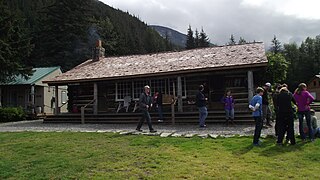
The Twin Glacier Camp, also known as the Twin Glacier Lodge and now Taku Glacier Lodge, is a historic wilderness recreation complex in Juneau Borough, Alaska. It is located on the southern banks of the Taku River, about 30 miles (48 km) from the city of Juneau.

The Valentine Building, also known as Valentine's Place and Valentine Business Block, is a historic commercial building at 202 Front Street in Juneau, Alaska. It is a prominent, irregularly-shaped two-story wood-frame structure, occupying an entire five-sided city block in the historic heart of the city. It was built in phases in 1904 and 1912 by Emery Valentine, a prominent local businessman who served as mayor of Juneau for six terms. For the first half of the 20th century, the Valentine building was one of Juneau's preeminent addresses, and the building remains a fine example of Alaskan frontier architecture.

Creek Street is a historic area of Ketchikan, Alaska. The street is actually a boardwalk mounted in stilts on a high slope on the east side of Ketchikan Creek, east of the city's downtown. Creek Street was listed on the National Register of Historic Places in 2014.

Kimball's Store, also known as Kimball Building, was a historic retail establishment at 500 and 504 West 5th Avenue in downtown Anchorage, Alaska. The dry goods store operated at the same site from 1915 to 2002, and its two-story wood-frame building is the only commercial building to survive at its original location from the period of Anchorage's founding. The store was established by Irving L. Kimball, who had been trading in Arctic communities of Alaska since 1897, and was operated afterward by his daughter until her death in 2002.

The Raymond Rebarchek Colony Farm is a historic farm property on Rebarchek Avenue in Palmer, Alaska. It consists of a 40-acre (16 ha) tract of land granted to Raymond Rebarchek in a 1935 land lottery organized by the Matanuska Valley Colony, a Depression-era agricultural colony project. The property was listed on the National Register of Historic Places in 1978. At that time, the farm complex included ten buildings, including Rebarcheck's original log house, a dairy barn, a well house, a greenhouse, and a chicken house. Only the original farmhouse, silo, and milking parlor are still standing today. The Alaska State Fair purchased the property in 2002 and is contemplating the establishment of a demonstration farm there.

The Wickersham House is a historic house museum at Pioneer Park ("Alaskaland") in Fairbanks, Alaska. The single-story wood-frame house was built in 1904 for James Wickersham, one of the dominant political figures of early 20th-century Alaskan history. It was the first frame house built in Fairbanks, and the first to feature a wooden sidewalk, picket fence, and grass lawn. The house was the first designated state landmark, designated by Governor Walter J. Hickel in May 1966. The house was rescued from demolition by the Fairbanks chapter of the Pioneers of Alaska, and moved from its original site at First and Noble Streets to the newly formed Alaskaland park in 1967. It is now a museum operated by the Tanana-Yukon Historical Society.

